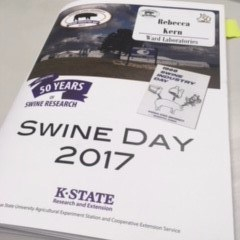
2017 KSU Swine Day
A couple of weeks ago I attended Swine Day for the second year in a row. This event is a great way to remain informed on the latest in swine nutrition research. I would recommend attending for anyone involved in the swine industry. It is also very interesting to see what the researchers are doing with all of the feed samples that go through Ward Laboratories, INC from the Kansas State University Swine Laboratory. The morning session consisted of quick 15 minute research updates on the projects in Manhattan, KS and with KSU cooperators. Two presentations that specifically caught my attention were the feed safety presentation by Dr. Cassie Jones and the Limonene presentation by Dr. Jim Nelssen. Finally, I would be doing a disservice to the lab if I did not highlight Dr. Chad Paulk’s presentation on sampling technique from feeders.
I often field phone calls from producers wanting to test for mycotoxins. These toxins are produced from specific strains of mold under certain conditions and often appear together. At Ward Laboratories, Inc., we only test for Aflatoxin, but always help people find a lab to test with if they would like to test other mycotoxins. Dr. Jones’ presentation focused on what we can do with contaminated feeds specifically corn grain and how some of our common practices to reduce shrink in feed mills may be contributing to mycotoxin contamination of feeds. Mycotoxin producing molds often thrive on broken kernels of corn. Therefore, Dr. Jones analyzed the effect of cleaning corn or separating the broken kernels from the intact kernels on mycotoxin contamination. She found that cleaning the corn kernels decreased aflatoxin by 26% and fumonisin by 45% in the cleanings. However, the screenings were concentrated with aflatoxin. Often these screenings are added back to other feeds to decrease shrinkage in the feed mill. Thus, hitting home the point that maybe a little shrinkage could be acceptable when taking into account the potential negative effects on animal health. A summary of this research can be found on page 54 of the 2017 Swine Day publication.
In the livestock industry across all species, consumers are driving increasing demand for antibiotic free products in supermarkets. Therefore, finding alternatives to antimicrobial products that boost performance in a comparable way is a lucrative research goal. According to Dr. Nelssen, antibiotic alternatives represent a $20 million global industry across all species and, in swine the cost of going antibiotic free is $20.68 / pig due to decreased growth rate. Therefore, his research compared average daily gain (ADG) in weaned pigs given feed four different feed treatments 1) Carbodox, an antibiotic fed for increased performance, 2) increased concentrations of copper and zinc, 3) the essential oil Limonene 4) a negative control diet. Limonene is already an approved product (Victus LIV) to replace Tylosin in beef cattle. The results of his study show that pigs supplemented with copper and zinc together or Limonene had higher ADG than the negative control diet and performed comparably with pigs supplemented with Carbodox. A summary of this research can be found on page 31 of the 2017 Swine Day Publication.
Many producers who want to sample their feed are often unsure of how to take an accurate and representative sample. For Hay samples I always refer them to the National Forage Testing Association guidelines, however for swine mixed feeds I have a hard time with a resource to direct them toward. Dr. Chad Paulk’s presentation focused on quality control in feeds testing. First, he compared probe samples to hand samples and found that the probe decreases variability among samples. Then, Dr. Paulk compared sampling individual feeders with taking a composite sample and determined that the composite sample also decreased variability. Additionally, the results showed that using a probe and a composite sample together reduced the number of samples needed to ensure an accurate result. Dr. Paulk’s final recommendation when taking a mixed feed sample from a feeder is:
- Utilize a probe
- Take 6 samples from 6 different feeders
- Combine those samples for one composite sample
A summary of this research can be found on page 55 of the 2017 Swine Day Publication.
Here just three topics covered of many in this year’s Swine Day at KSU have been highlighted. I would encourage all involved in this ever changing industry to attend this event in the future and check out the information they have made available through the links I have included below. As for those of you looking to take a feed sample, don’t overlook the importance of an accurate representative sample. Consider taking advantage of the technique outlined above.
Presentations: https://www.asi.k-state.edu/events/swine-day/presentations.html
Publications: http://newprairiepress.org/kaesrr/vol3/iss7/
